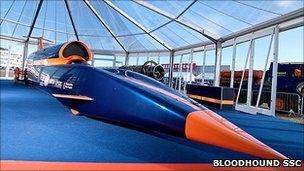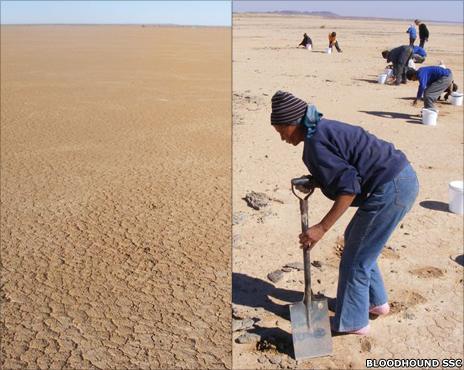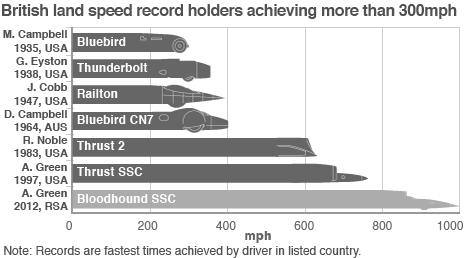1,000mph car project 'on track'
- Published

Bloodhound model: Construction of the real supersonic car starts in the New Year
The British project to develop a 1,000mph car is on target to meet its goals, says director Richard Noble.
Construction will start on the rear of the Bloodhound vehicle in January, with an attempt on the World Land Speed record expected in 2012.
"We've got companies all over the world wanting to sponsor the car," Mr Noble told BBC News.
"We've actually got more people who want to financially back this thing than we've got space for them."
Mr Noble has made an appeal for people to help prepare the vehicle's race track.
This is a dried-up lake bed in Northern Cape Province, South Africa, known as Hakskeen Pan.
Before the Bloodhound car can hurtle across this flat expanse of land, it must be cleared of all loose stones.
A rock thrown up at 1,000mph has the potential to do serious damage to the car's thin alloy bodywork and even cripple its four solid aluminium wheels.

How Hakskeen Pan will look (left) after the clearance work (right) has removed the loose stones
With the assistance of the Northern Cape government, work has just started to prepare the track. A team of 300 local people has begun sweeping an area 20km x 1.5km, picking up any stones in their path.
Mr Noble has placed a light-hearted advert in Monday's London Times newspaper calling on UK volunteers to go out to the Northern Cape to join in the back-breaking effort.
It promises: "No wages, constant heat, tough work in beautiful but remote Hakskeen Pan… Scorpions may be present. Inspiring next generation of engineers the reward."
It echoes a famous advertisement reputed to have been placed in papers 100 years ago by the Antarctic explorer Ernest Shackleton as he sought volunteers for one of his expeditions. Shackleton's ad was said to have warned applicants that their safe return could not be guaranteed.
Bloodhound track preparation should not be quite so dramatic or dangerous as a Shackleton expedition.
"The volunteers have got to support themselves, but the cost of living out there is not great. It's an opportunity to be a part of an extraordinary experience," he told BBC News.
Wing Commander Andy Green gives a tour of the Bloodhound SSC model
The Bloodhound project was conceived as way of promoting science and engineering to young people. The development of the car has been accompanied by a huge educational programme in British schools.
To claim the World Land Speed record, Bloodhound will have to better the mark of 763mph (1,228km/h) set by the Thrust SuperSonic Car in 1997.
It will be powered by a combination of a hybrid rocket and a jet engine from a Eurofighter-Typhoon.
Three who worked on Thrust are also engaged in the Bloodhound project, including driver Wing Cmdr Andy Green, the chief aerodynamicist Ron Ayers, and director Richard Noble, who as a driver held the record himself in the 1980s.
Although a private, not-for-profit venture, Bloodhound has been given not-inconsiderable in-kind support by the UK government, which has loaned the project two Typhoon engines.
Major aerospace companies are involved. Hampson Industries will build the rear of the car, while Lockheed Martin is working on its 90cm-diameter, 97kg wheels. F1 engine manufacturer Cosworth has recently joined the project. One of its power units will be used to drive the liquid oxidiser into Bloodhound's rocket.
The project still has some way to go to meet its funding objectives but Mr Noble said he was now confident it would all come together: "It's quite clear it's going to happen now."

- Published13 November 2010
- Published10 November 2010